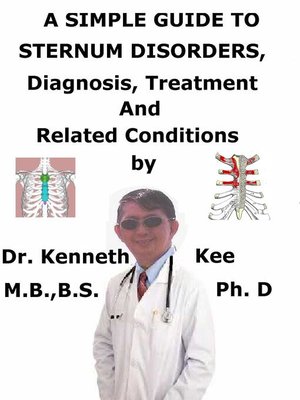A Simple Guide to Sternum Disorders, Diagnosis, Treatment and Related Conditions
ebook
By Kenneth Kee

Sign up to save your library
With an OverDrive account, you can save your favorite libraries for at-a-glance information about availability. Find out more about OverDrive accounts.
Find this title in Libby, the library reading app by OverDrive.



Search for a digital library with this title
Title found at these libraries:
| Library Name | Distance |
|---|---|
| Loading... |
This book describes Sternum Disorders, Diagnosis and Treatment and Related Diseases
The sternum is a flat bone that is sited in the center of the anterior thoracic wall.
It consists of three segments;
1. Manubrium (uppermost part)
2. Body (middle part) and
3. Xiphoid process (lowest part).
The manubrium attaches to the clavicles, the first ribs and the superior part of the second costal cartilages.
The manubrium is quadrangular in shape and lies at the level of the 3rd and 4th thoracic vertebrae.
The jugular (suprasternal) notch is the thickest piece of the manubrium and is convex when views anteriorly and concave posteriorly.
The body of the sternum is elongated and is thinner than the manubrium.
Its margins attach with the inferior part of the 2nd costal cartilages, the 3rd to 6th costal cartilages and the superior part of the 7th costal cartilage.
The xiphoid process is the lowest and tiniest part of the sternum.
It attaches with the inferior part of the 7th costal cartilage and supplies attachment for rectus abdominis, transversus abdominis aponeurosis, transversus thoracis and the abdominal diaphragm.
Sternum Disorders are a group of congenital diseases that span a broad spectrum of disorders.
These can manifest as isolated disorders or can relate with extra-thoracic anomalies and genetic syndromes.
Detrimental effects can happen from birth to adolescence, varying from life-threatening disorders to psychosocial cosmetic concerns.
Some of the most frequent causes of sternum disorders are:
Costochondritis
Tietze Syndrome
Pectus Excavatum
Pectus Carinatum
Collarbone injuries
Sternoclavicular joint injury
Sternum fracture
Muscular strain or bruise
Musculoskeletal Causes
Stress fractures of the sternum
Clavicle fractures
Stress fractures of the rib
Joint Sub-luxations
Sternoclavicular joint disorders
Costochondritis
Tietze syndrome
Inflammatory joint disease
Fibromyalgia
General myalgia
Xiphodynia (or painful/hypersensitive xiphoid syndrome)
Pectoral muscle rupture
Injuries to muscles other than pectoris
Slipping rib syndrome
Post-surgery injuries
Osteomyelitis
Causes of Sternum Pain:
Cardiovascular Causes
Heart valve disease
Hyper-trophic cardiomyopathy
Coronary artery disease
Myocarditis
Pericarditis
Aortic dissection
Respiratory Causes
Asthma
Exercise-induced Asthma/Bronchoconstriction
Bronchitis
Bronchiectasis
Chronic Obstructive Pulmonary Disease (COPD)
Tracheitis
Tuberculosis
Pulmonary embolism
Pleurisy
Pneumothorax
Pulmonary hypertension
Pulmonary sarcoidosis
Abdominal and Gastrointestinal Causes
Gastroesophageal reflux disease (GERD)
Pancreatitis
Referred pain from the esophagus
Boerhaave's Syndrome
Referred Pain
Shoulders
Cervical spine
Thoracic spine
Cancer
Breast cancer
Lung cancer
Lymphoma
Bone cancer
Diagnosis
X-rays are also conducted to rule in/out fractures
CT scans and MRIs may be indicated for suspected bony injury and neoplasms
Nuclear scintigraphy (organ scanning) may be positive with costochondritis
Treatment
The main treatment is with medical treatment, surgical repair, and genetic counseling
Reassurance, pain control (e.g. analgesics, heat) and avoidance of aggravating activities
Conservative treatment involving joint manipulation
Surgical debridement may be indicated
TABLE OF CONTENT







